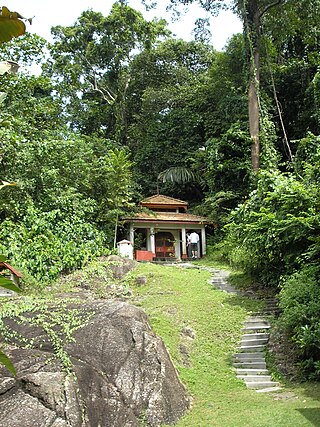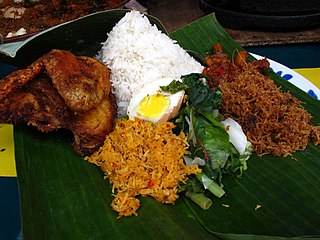Related Research Articles

Jemaah Islamiyah was a Southeast Asian Islamist militant group based in Indonesia, which was dedicated to the establishment of an Islamic state in Southeast Asia. On 25 October 2002, immediately following the JI-perpetrated 2002 Bali bombings, JI was added to the UN Security Council Resolution 1267.

Laksa is a spicy noodle dish popular in Southeast Asia. Laksa consists of various types of noodles, most commonly thick rice noodles, with toppings such as chicken, prawns or fish. Most variations of laksa are prepared with a rich and spicy coconut curry soup or a broth seasoned with asam.

Bak kut teh is a pork rib dish cooked in broth popularly served in Malaysia and Singapore where there is a predominant Hoklo and Teochew community.

The Sama-Bajau include several Austronesian ethnic groups of Maritime Southeast Asia. The name collectively refers to related people who usually call themselves the Sama or Samah ; or are known by the exonym Bajau. They usually live a seaborne lifestyle and use small wooden sailing vessels such as the perahu, djenging (balutu), lepa, and vinta (pilang). Some Sama-Bajau groups native to Sabah are also known for their traditional horse culture.

Cendol is an iced sweet dessert that contains droplets of pandan-flavoured green rice flour jelly, coconut milk and palm sugar syrup. It is commonly found in Southeast Asia and is popular in Indonesia, Malaysia, Brunei, Cambodia, East Timor, Laos, Vietnam, Thailand, Singapore, Philippines, and Myanmar. Next to the green jelly, additional toppings might be added, including diced jackfruit, sweetened red azuki beans, or durian.

Na Tuk Gong are local guardian spirits worshipped by overseas Chinese communities in Malaysia, Singapore and parts of Indonesia, especially Sumatra. An alternate more generic name for the cult is Datuk Gong, uniting Dato or Datuk from the local Malay word for 'grandfather', which is also used as an honorific title, and Kong or Gong from Chinese, also an honorific title. According to Taoist tradition, a Na Tuk Kong's could hold the official title 拿督尊王. It is important to note that Datuk Keramat, Datuk Gong and Na Tuk Kong all refer to the same deity. For the sake of clarity, the term Datuk, which is universally used to describe the spirit in Malaysia, will be used.

Lontong is an Indonesian dish made of compressed rice cake in the form of a cylinder wrapped inside a banana leaf, commonly found in Indonesia, Malaysia, and Singapore. Rice is rolled inside a banana leaf and boiled, then cut into small cakes as a staple food replacement for steamed rice. The texture is similar to that of ketupat, with the difference being that the ketupat container is made from woven janur fronds, while lontong uses banana leaf instead.

The religious belief of the Datuk Keramat worship can be found in Malaysia, Singapore and along the Strait of Malacca. It is a fusion of Malaysian folk religion, Sufism, and Chinese folk religion in Southeast Asia.

Klepon or kelepon or kalalapun, also known outside Java as onde-onde and buah melaka, is a sweet rice cake ball filled with molten palm sugar and coated in grated coconut. Of Javanese origin, the green-coloured glutinous rice balls are one of the popular traditional kue in Indonesian cuisine.

Overseas Indonesians are Indonesians who live outside of Indonesia. These include citizens that have migrated to another country as well as people born abroad of Indonesian descent. According to Ministry of Law and Human Rights, more than 6-9 million Indonesians diaspora live abroad in 2023.

Nasi ulam is a traditional Indonesian dish of steamed rice (nasi) served with various herbs and vegetables (ulam).

Nasi ambeng or Nasi ambang is an Indonesian fragrant rice dish that consists of—but is not limited to—steamed white rice, chicken curry or chicken stewed in soy sauce, beef or chicken rendang, sambal gorengurap, bergedel, and serunding.

Nasi padang, sometimes referred to as Padang rice, is a Minangkabau dish of steamed rice served with various choices of pre-cooked dishes originating from West Sumatra, Indonesia. It is named after the city of Padang, capital of the West Sumatra province. A miniature banquet of meats, fish, vegetables, and spicy sambals eaten with plain white rice, it is Sumatra's most famous export and the Minangkabau people's primary contribution to Indonesian cuisine.

Dodol is a sweet toffee-like sugar palm-based confection commonly found in Southeast Asia and the Indian subcontinent. Originating from the culinary traditions of Indonesia, it is also popular in Malaysia, Singapore, Brunei, the Philippines, Southern India, Sri Lanka, Thailand, and Burma, where it is called mont kalama. It is made from coconut milk, jaggery, and rice flour, and is sticky, thick, and sweet.

Roti canai, or roti prata, also known as roti chanai and roti cane, is an Indian flatbread dish found in several countries in Southeast Asia, especially Brunei, Indonesia, Malaysia, Singapore, and Thailand. It is usually served with dal or other types of curry but can also be cooked in a range of sweet or savoury variations made with different ingredients, such as meat, eggs, or cheese.

The Tahlil, also spelled Tahleel, is a form of dhikr that involves the praising of God in Islam by saying "There is no god but Allah. He has no partner with Him".

Guazi, also called kwasi refers to roasted plant seeds. It is a popular snack in China, Malaysia and overseas Chinese communities, especially in Indonesia. While directly translated as "melon seeds" it usually refers to baked seeds of the sunflower, pumpkin, or watermelon seeds. It is often served as an appetizer during banquets.

The Royal Family Order of the Crown of Brunei is an order of Brunei. It was established on 15 August 1982 by Sultan Hassanal Bolkiah. The order carries the post-nominal letters "DKMB".
A Tablighi Jamaat religious conference that took place at the "Masjid Jamek Sri Petaling" in Kuala Lumpur's Sri Petaling district between 27 February to 1 March 2020 became a COVID-19 super-spreader event with more than 3,300 cases being linked to the event. By 19 May 2020, the Malaysian Director-General of Health Noor Hisham Abdullah confirmed that 48% of the country's COVID-19 cases (3,347) had been linked to the Kuala Lumpur Tablighi Jamaat cluster. Additionally, nearly 10% of attendees were overseas visitors, causing COVID-19 to spread to other countries in Southeast Asia. On 8 July 2020, this cluster was declared over by the Ministry of Health.
References
- ↑ Sardjono, M. Budi. Ibadat dalam Kenduri: Sebagai Sarana Pewartaan (in Indonesian). PT Kanisius. ISBN 978-979-21-4992-0.
- ↑ Lockard, Craig A.; Bin Ahmad, Zakaria (21 September 2024). "Malaysia - Culture, Cuisine, Traditions". Britannica. Retrieved 21 September 2024.